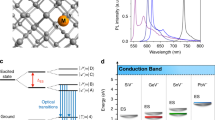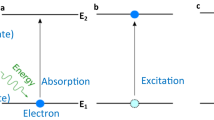Abstract
Single-photon sources that provide non-classical light states on demand have a broad range of applications in quantum communication, quantum computing and metrology1. Single-photon emission has been demonstrated using single atoms2, ions3, molecules4, diamond colour centres5,6 and semiconductor quantum dots7,8,9,10,11. Significant progress in highly efficient8,11 and entangled photons9 sources has recently been shown in semiconductor quantum dots; however, the requirement of cryogenic temperatures due to the necessity to confine carriers is a major obstacle. Here, we show the realization of a stable, room-temperature, electrically driven single-photon source based on a single neutral nitrogen-vacancy centre in a novel diamond diode structure. Remarkably, the generation of electroluminescence follows kinetics fundamentally different from that of photoluminescence with intra-bandgap excitation. This suggests electroluminescence is generated by electron–hole recombination at the defect. Our results prove that functional single defects can be integrated into electronic control structures, which is a crucial step towards elaborate quantum information devices.
This is a preview of subscription content, access via your institution
Access options
Subscribe to this journal
Receive 12 print issues and online access
$209.00 per year
only $17.42 per issue
Buy this article
- Purchase on Springer Link
- Instant access to full article PDF
Prices may be subject to local taxes which are calculated during checkout




Similar content being viewed by others
References
Santori, C., Fattal, D. & Yamamoto, Y. Single-Photon Devices and Applications (Wiley, 2010).
Kuhn, A., Hennrich, M. & Rempe, G. Deterministic single-photon source for distributed quantum networking. Phys. Rev. Lett. 89, 067901 (2002).
Keller, M., Lange, B., Hayasaka, K., Lange, W. & Walther, H. Continuous generation of single photons with controlled waveform in an ion-trap cavity system. Nature 431, 1075–1078 (2004).
Lounis, B. & Moerner, W. E. Single photons on demand from a single molecule at room temperature. Nature 407, 491–493 (2000).
Kurtsiefer, C., Mayer, S., Zarda, P. & Weinfurter, H. Stable solid-state source of single photons. Phys. Rev. Lett. 85, 290–293 (2000).
Aharonovich, I. et al. Diamond-based single-photon emitters. Rep. Prog. Phys. 74, 076501 (2011).
Michler, P. et al. A quantum dot single-photon turnstile device. Science 290, 2282–2285 (2000).
Yuan, Z. et al. Electrically driven single-photon source. Science 295, 102–105 (2002).
Salter, C. L. et al. An entangled-light-emitting diode. Nature 465, 594–597 (2010).
Kako, S. et al. A gallium nitride single-photon source operating at 200 K. Nature Mater. 5, 887–892 (2006).
Strauf, S. et al. High-frequency single-photon source with polarization control. Nature Photon. 1, 704–708 (2007).
Beveratos, A. et al. Single photon quantum cryptography. Phys. Rev. Lett. 89, 187901 (2002).
Jacques, V. et al. Experimental realization of Wheeler's delayed-choice gedanken experiment. Science 315, 966–968 (2007).
Mizuochi, N. et al. Coherence of single spins coupled to a nuclear bath of varying density. Phys. Rev. B 80, 041201(R) (2009).
Balasubramanian, G. et al. Ultralong spin coherence time in isotopically engineered diamond. Nature Mater. 8, 383–387 (2009).
Fuchs, G. D. et al. Gigahertz dynamics of a strongly driven single quantum spin. Science 326, 1520–1522 (2009).
Dutt, M. V. G. et al. Quantum register based on individual electronic and nuclear spin qubits in diamond. Science 316, 1312–1316 (2007).
Neumann, P. et al. Multipartite entanglement among single spins in diamond. Science 320, 1326–1329 (2008).
Buckley, B. B., Fuchs, G. D., Bassett, L. C. & Awschalom, D. D. Spin-light coherence for single-spin measurement and control in diamond. Science 330, 1212–1215 (2010).
Togan, E. et al. Quantum entanglement between an optical photon and a solid-state spin qubit. Nature 466, 730–735 (2010).
Koizumi, S., Watanabe, K., Hasegawa, M. & Kanda, H. Ultraviolet emission from a diamond pn junction. Science 292, 1899–1901 (2001).
Makino, T. et al. Enhancement in emission efficiency of diamond deep-ultraviolet light emitting diode. Appl. Phys. Lett. 99, 061110 (2011).
Zaitsev, A. M., Bergman, A. A., Gorokhovsky, A. A. & Huang, M. Diamond light emitting diode activated with Xe optical centers. Phys. Status Solidi (a) 203, 638–642 (2006).
Hauf, V. et al. Chemical control of the charge state of nitrogen-vacancy centers in diamond. Phys. Rev. B 83, 081304(R) (2011).
Babinec, T. M. et al. A diamond nanowire single-photon source. Nature Nanotech. 5, 195–199 (2010).
Watkins, P. W. Physical Chemistry 4th edn, ch. 26 (Oxford Univ. Press, 1989).
Sze, S. M. et al. Physics of Semiconductor Devices (Wiley-Interscience, 2006).
Gali, A. Theory of the neutral nitrogen-vacancy center in diamond and its application to the realization of a qubit. Phys. Rev. B 79, 235210 (2009).
Watanabe, H., Kitamura, T., Nakashima, S. & Shikata, S. Cathodoluminescence characterization of a nitrogen-doped homoepitaxial diamond thin film. J. Appl. Phys. 105, 093529 (2009).
Felton, S. et al. Electron paramagnetic resonance studies of the neutral nitrogen vacancy in diamond. Phys. Rev. B 77, 081201 (2008).
Lohrmann, A. et al. Diamond based light-emitting diode for visible single-photon emission at room temperature. Appl. Phys. Lett. 99, 251106 (2011).
Acknowledgements
The authors acknowledge financial support by the Japan Science and Technology Agency (JST) Precursory Research for Embryonic Science and Technology (PRESTO) programme, as well as KAKENHI (grant nos 22102502 and 23681017), the Strategic Information and Communication R&D Promotion Program (SCOPE), the National Institute of Information and Communications Technology (NICT) programme, the JST Core Research for Evolutional Science and Technology (CREST) programme, the European Union (EU) via the grants Solid State Quantum Technology and Metrology Using Spins (SQUTEC), DIAMANT and Solid State Systems for Quantum Information Processing (SOLID), the Deutsche Forschungsgemeinschaft (DFG) via research groups 730, 1482 and 1495, the Max Planck Society, and the Hungarian Scientific Research Fund (OTKA; grant no. K-67886).
Author information
Authors and Affiliations
Contributions
T.M., H.K., D.T. and M.O. synthesized and fabricated the diamond device. N.M. built a home-made confocal microscope system with assistance from P.N., F.J. and J.W., and carried out the measurements. N.M., M.N., H.O., S.Y., P.N., F.J. and J.W. contributed to the data analysis. A.G. carried out group theory analysis and the ab initio calculations. N.M. and J.W. wrote the manuscript with feedback from all authors. All authors discussed the results and commented on the manuscript.
Corresponding author
Ethics declarations
Competing interests
The authors declare no competing financial interests.
Supplementary information
Supplementary information
Supplementary information (PDF 707 kb)
Rights and permissions
About this article
Cite this article
Mizuochi, N., Makino, T., Kato, H. et al. Electrically driven single-photon source at room temperature in diamond. Nature Photon 6, 299–303 (2012). https://doi.org/10.1038/nphoton.2012.75
Received:
Accepted:
Published:
Issue Date:
DOI: https://doi.org/10.1038/nphoton.2012.75
This article is cited by
-
Ultrafast laser-induced self-organized nanostructuring in transparent dielectrics: fundamentals and applications
PhotoniX (2023)
-
Applications of single photons to quantum communication and computing
Nature Reviews Physics (2023)
-
Crystal orientation effects on the optical properties of wurtzite GaN/AlN quantum dots on semi-polar substrates
Optical and Quantum Electronics (2023)
-
Recent advances in room temperature single-photon emitters
Quantum Information Processing (2023)
-
Electrical control of quantum emitters in a Van der Waals heterostructure
Light: Science & Applications (2022)



